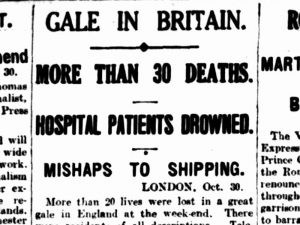Event in Focus: October 1927 – Fatalities in a flooded hospital
During this week 90 years ago a sever flood and storm event directly claimed six lives around the UK coastline, including 3 bed bound hospital patients. The overall reported death toll attributed to the storm (though not directly attributed to flood water) exceeds thirty people.
During 27th October 1927, the storm began to form over the central North Atlantic at around 40o N. It followed a northwesterly path towards the British Isles, generating southwesterly winds in its wake with a modest central air pressure of approximately 985 mbar. At Valentia, Ireland the wind speed was reportedly around 60 mph, and a [gust] of 78 mph was recorded (The Argus, 1927).

Headlines on the day
This event is notable for severe flooding in Fleetwood, Lancashire where 6 people, including three hospital patients, were drowned [one body washed 150 yards away] when a storm surge of “unparalleled height” breached the sea wall (Lamb, 1991; Fleetwood Weekly News, 2007; Wyre Council, 2013). Around 5 km2 of the Fylde peninsula was inundated by an estimated 41 million tons of water, in parts up to 12 ft. [3.7 m] deep (Met Office, 1927; Wyre Council, 2013). Around 10,000 people (45% of the population) in Fleetwood were “badly” affected and over 1,200 properties “seriously” damaged (The Times, 1927; Wyre Council, 2013). Coastal cottages at Criccieth were described as being left “tumbled” down by the water (Lamb, 1991), and one Fleetwood resident said he had counted nine caravans floating past his house (The Times, 1927). There were also serious impacts on infrastructure and public services. Lancaster Isolation Hospital was flooded when the River Lune overflowed its banks and three tuberculosis patients, who were sleeping on the ground [floor], were drowned (The Argus, 1927).
According to Wyre Borough Council (2013), road and rail links to Fleetwood were cut off, while gas and electricity supplies were “severed”. The electricity works were also flooded which “plunged the town into darkness” (The Times, 1927). With some areas flooded for a number of days, the weight of the floodwater left telephonic and telegraphic cables broken. The flood extended inland as far as Aberglaslyn and drowned many cattle (Lamb, 1991). In total, there were around 30 deaths according to The Argus (1927), with several boating incidents including 12 fisherman who were drowned in Tellegan Bay, Ireland (Nambour Chronicle and North Coast Advertise, 1927). Damage to the sea wall in Fleetwood was estimated at £11,000, equivalent to around £0.6m today (BBC, 1986; Lamb, 1991). Several other locations across the northwest were reportedly affected including Blackpool, Sandylands, Criccieth, Aberglaslyn and Portmadoc. During the immediate aftermath, pumping operations were compounded by heavy rain (The Argus, 1927). The town was isolated for 2 days, and some areas remained under several feet of water even 3 days after the breach (The Times, 1927). The lack of light and unoccupied properties also led to looting taking place. A later inquest concluded that future use of the flooded hospital is not recommended (The Times, 1927).

Newspaper report in full
